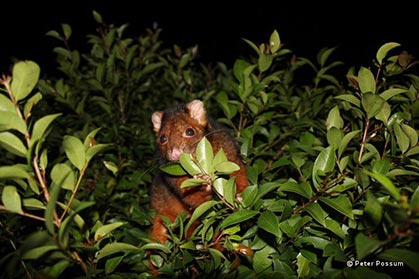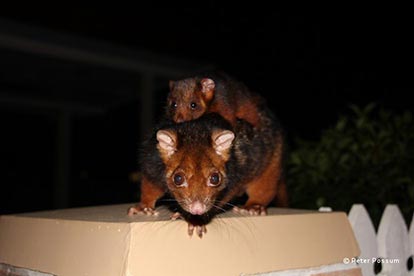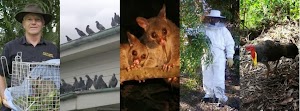1. ANIMAL DESCRIPTION
Common name: Common Ringtail Possum
Scientific name: Pseudocheirus peregrinus
There are a number of subspecies but this description concentrates on those found around Brisbane.
SIZE
This Australian marsupial has a full grown adult body size of around 300 to 350mm long for both the male and female of the species. The tail of the Ringtail Possum is another 300 to 350 mm long.
WEIGHT
Adult weight when fully grown is around 700 grams to 1100 grams which is a lot smaller than the Brushtail Possum, which can weigh over 4 kilos.
FEATURES AND COAT
The Ringtail is a marsupial with eyes that are suited for night time vision as it is a nocturnal creature. It has three pairs of upper incisors front teeth and one pair of lower incisors. Its head is rounded with small set eyes that tend to have a bulging appearance. Its ears are short rounded and have pale fur behind them.
The Ringtails markings of its fur coat can vary from an overall dark grey to jet black. In Brisbane, the overall pelt of the Ringtail typically appears to have fur tinged with a red to orange colouration but colours can extend to even a white to red-orange under markings and red to orange leg markings.
The tail has a white tip and its underside is bald. The tail is used by the possum to balance and jump between trees. When the tail is not being utilized like a 5th leg the Ringtail usually carries it in a coiled position, with the coil in a vertical roll and raised up off the ground.
It is frequently confused in urban environments with the common Brushtail possum. Humans readily think they are the same although they are not. The Brushtail is usually the ‘nuisance’ possum which interferes with manmade structures and gardens. The Ringtail is smaller than the Brushtail and prefers to live in dense bush foliage.
It is unusal to find Ringtail Possums inside a roof of a house. Around Brisbane it certainly does happen and they will frequently sleep in a small nest of branches that they build under an overhang of the roof, but that means they are ON the roof and not inside.
They prefer to build a nest (called a drey) in a tree and their nests are often mistaken for rather large and untidy bird’s nests.
The Ringtail has a different paw shape from the Brushtail. The Ringtail has 2 fingers opposing the opposite 3 fingers.
Like all marsupials, the female ringtail has a pouch located on her abdominal region for the gestation of the young. The male of the species has scent glands located under his chin, down his chest and near the anal area specifically designed to allow him to mark his territory with his strong individual scent. The chest scent glands are most prevalent during the mating season from May to July and September to November when it darkens to a reddish brown “stained” area along the lighter chest fur.

Ringtail Possum
2. ECOLOGY
The Ringtail lives along the east coast of Australia from the north of Queensland down through New South Wales, into Victoria and even has a sub-species located in Tasmania.
It prefers to shelter in the hollow of trees or builds its own nest – known as a ‘drey’ – out of a combination of twigs, sticks, bark and other grasses and bark strips located in the nesting area. The drey is usually around 30 centimetres in diameter and is used as living quarters for the Ringtail possums. The round entrance of the drey is around 10 centimetres in diameter.
Ringtail are extremely adaptable and are often found in the built environment of cities and towns, hence their familiarity with human beings. In fact they are quite common in the Brisbane CBD. Being nocturnal (night time active) creatures they are generally not seen by humans. During the daytime they nest in hollow trees and branches or shelter in thick trees or bush foliage away from predators. However it is not at all unusual for them to be seen moving about during the day, often pursued by some noisy minor birds and even crows. In Peter Possum’s experience, the birds swooping on a ringtail do not do any harm to it unless it has been injured in say a car collision. In fact the possums are capable of catching and killing the bird.
Their diet is mostly vegetarian consisting of flowers, buds, succulent leaves and sometimes seasonal fruits. By eating its own faecal pellets, the Ringtail digests its food twice to extract the maximum amount of nutrients. This is a behaviour common to many native animals that eat leaves which have a low nutritional value and so are hard to digest (which includes the leaves of many Australian natives and is the same problem confronted by the koala’s digestive system).
The ringtail will take opportunities to vary its diet. Observers have noted that birds that nest near a drey will frequently have the eggs raided within 1 week of the eggs being laid (most likely due to the Ringtail possum.)
3. BEHAVIOUR
The Ringtail normally becomes nocturnally active around twilight after sunset. They remain active until midnight when they return to their drey or nesting location. Their return to the nest usually occurs around the time the air temperature drops to its lowest point for the night.
They use several common mediums for communication. Sound, smell, visual and physical contact are common traits. Aggressive encounters are also common to establish hierarchy and territory between possums and different groups of possums.
The Ringtail is less vocal than a Brushtail (which has around 18 different vocal noises) and does not have the explosive aggressive vocal noises of the Brushtail and therefore has less impact upon humans. The Ringtail usually uses a high pitched call described as a chirrup noise.
They rely on scent glands to communicate several different messages to other possums. The scent of an individual does indicate social standing, bonds between families, gender, breeding capabilities, reproduction cycles and territory between groups. The Ringtail can produce scents from areas located near its mouth, chest, ears, pouch and fingers as well as the anus and reproductive organs. These scents are spread to trees and branches by rubbing these body parts on the foliage or secreting urine and the like during their travels.
4. BREEDING
The Ringtail possum usual breeding season is between May to July and September to November. The female has an oestrus cycle of 28 days and a female enters the breeding age at around 14 months. The gestation period of the Ringtail is estimated at around 18 days.
The number of offspring can vary from 1 to 3 and two is quite common. It has been observed that unlike the Brushtail, the Ringtail mother is readily able to rear two young successfully to maturity.
The young usually weens from the mother around the age of 7 months. Unfortunately the mortality of the young is extremely high at around 45% to 95% by the age of 12 months.
They can produce two litters in a year. This is rare but usually occurs when a female has lost her first litter. It can also occur when the female had a litter very early in the season and the young have developed enough to be mostly independent from the mother. The mother will usually be at a heavier healthy body weight to be able to produce the second litter, so plentiful food supplies are essential.
The male Ringtail is not reproductively active all year round. The males tend to have their testes regress in the non-breeding months. It is believed to be the only species of possum in which the male helps to care for the young.
As with the Brushtail, in the pouch the very young baby is hairless and is called a ‘pinkie’. The name ‘pinkie’ lasts until the baby develops fur and seals its mouth round the mother’s teat. The ‘pinkie’ stays in the pouch until its fur develops into a full coat. The eyes open up at around 100 days.
The young then moves onto the mother’s back at the age of around 4 months and will weigh between 65 to 90 grams.
Brisbane wildlife controller, Peter the Possum & Bird Man, has successfully caught and removed Ringtail possums from Brisbane homes. However it is a rare event compared to times when Brushtails are found inside a roof.

Mum and Baby Ringtail Possum
5. HOME OWNER PROBLEMS
Due to the Ringtail assimilation into the built environment of the human population it has been labelled as a pest in some areas. It is known to cause minor damage to trees and impact the growth of gardens, flowers and fruit trees. The occurrence of possums in Brisbane is thought to be on the increase probably because they find it easy to locate food in built up areas from domestic gardens with many of their favourite native trees as well as fruit trees. This ensures they can thrive in residential areas due to the abundance of readily accessible food sources.
While the Brushtail will eat a range of foods, the Ringtail tends to show a strong preference for native flowers and leaves, but they are partial to some of the exotic plants that homeowners like to have in their gardens including flowering plants, herbs and vegetables.
When they decide to live in the roof of a house, Possum removal becomes the highest priority for the concerned home owner.
Brushtails have some diseases including bovine tuberculosis but the diseases carried by a Ringtail have not been fully studied. This is another high concern for home owners in Brisbane.
Signs that a possum is using your house, as his house, are a concentration of droppings around the eaves Loud noises such as scratching, rustling and scampering noises on the roof are a sign that a Ringtail possum may have made a nest on-top of your roof or under an overhang. The best way to remove them is to engage Pest the Possum and Bird Man to investigate and recommend the best course of action, to either trap the possum if it is inside, fit mesh proofing to exclude the ringtail from the area on the roof that it is using for shelter and also maybe to provide a nest box.
6. SUMMARY – HOW CAN PETER THE POSSUM MAN HELP YOU?
Apart from sleepless nights due to the noise that your new resident may make, there is the risk of mess, damage to wood and wiring and they may carry disease. So requesting an experienced professional like Peter the Possum and Bird Man to remove the possum is advisable. By acting quickly and contacting us for advice on catching possums when you discover you have an unwanted possum in your house, you can prevent expensive damage to your asset.
Call Peter the Possum & Bird Man and ask for the friendly serviceman who is the Brisbane possum removalist. Our experienced possum catchers will get rid of to your unwanted pesky possum promptly and efficiently. We have over 25 years of experience and we know all of the animal friendly techniques for trapping possums.
We not only remove the possum but will also repair and modify your house’s susceptible entry points for possum proofing as well. So not only do you say ‘good bye’ and get rid of the possum as an unwanted guest but your house is also repaired and made possum proof for the future.
So if you have a possum in your property call Peter the Possum Man and ask for assistance from your local experienced Brisbane possum removalist.







